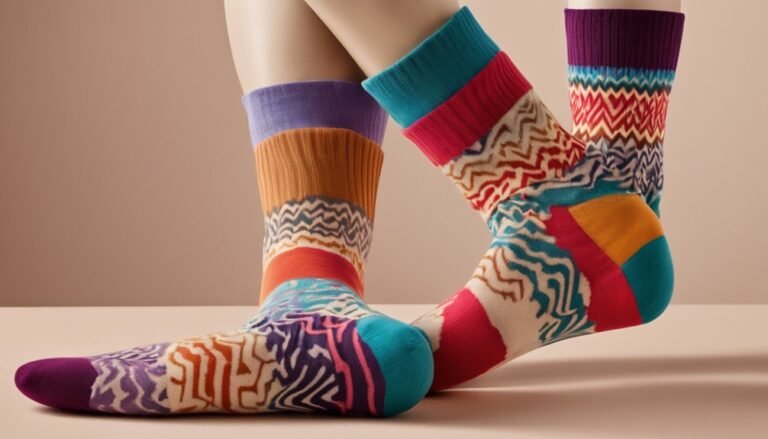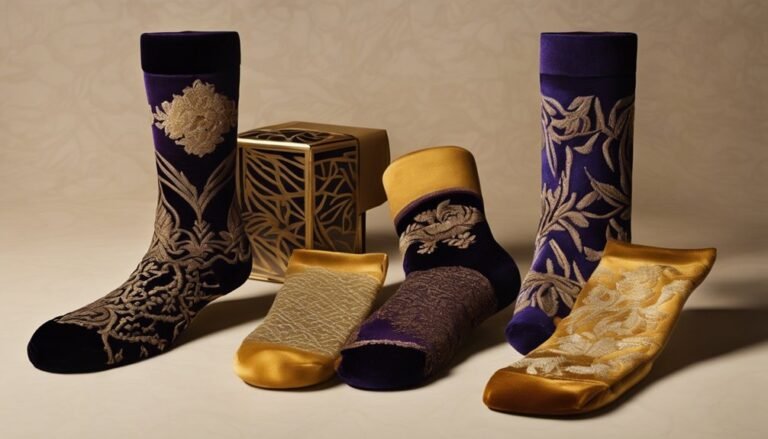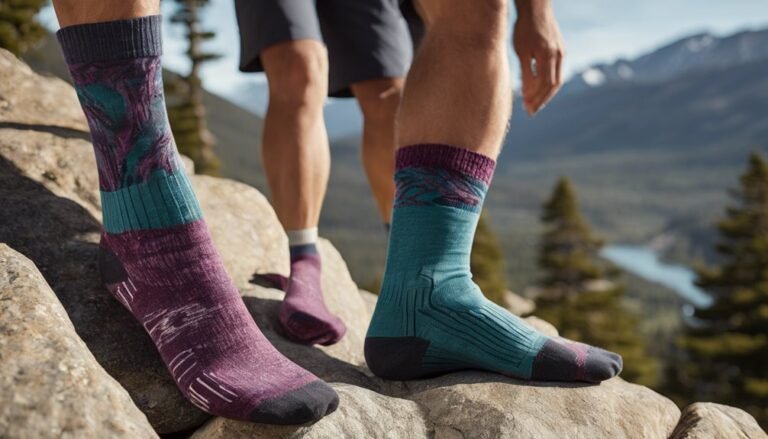Summer Hiking Socks vs. Winter Hiking Socks: What’s the Difference?
When comparing summer and winter hiking socks, consider their primary functions. Summer socks focus on lightweight breathability and moisture-wicking materials to keep your feet cool and dry. In contrast, winter socks prioritize insulation and cushioning to provide warmth and support in cold conditions. Materials like merino wool and synthetic blends are common in both. Understanding these differences is essential to enhancing your hiking experience, allowing you to choose the right sock for any weather. Learn more about specific features in each category.
The Importance of Choosing the Right Sock for the Season

When you're gearing up for a hike, choosing the right sock for the season is essential for both comfort and performance. Seasonal adaptability in your sock selection can greatly impact your experience on the trail. In warmer months, lightweight, moisture-wicking materials help keep your feet dry and reduce the risk of blisters. Conversely, in colder conditions, you'll want socks that provide insulation and moisture management to maintain warmth and prevent dampness. The right choice enhances sock performance, ensuring your feet stay comfortable regardless of the weather. Prioritizing materials like merino wool for winter or synthetic blends for summer can make a real difference. Remember, the freedom of the great outdoors is best enjoyed with the right gear supporting every step you take.
Key Features of Summer Hiking Socks
Choosing the right socks for summer hiking involves understanding the key features that enhance your comfort and performance on the trail. Look for breathable materials like merino wool or synthetic blends that wick moisture away, keeping your feet dry and reducing the risk of blisters. Lightweight construction is essential, as it helps maintain agility and prevents overheating during warm weather hikes. Additionally, consider socks with mesh panels for added ventilation. A snug fit without excessive cushioning is ideal, allowing your feet to move naturally while providing support. Finally, opt for seamless designs to minimize friction. By focusing on these features, you'll enjoy a more comfortable and enjoyable hiking experience in the summer months.
Key Features of Winter Hiking Socks
Although winter hiking can present unique challenges, selecting the right socks is vital for maintaining warmth and comfort on the trail. Winter hiking socks typically offer various insulation types, such as merino wool or synthetic blends, which help trap heat while wicking moisture away. You'll want to take into account sock thickness as it plays a significant role in insulation; thicker socks can provide extra warmth but may reduce breathability. Look for options that feature cushioning in high-impact areas to prevent blisters and enhance comfort. Additionally, reinforced heels and toes improve durability, ensuring your socks withstand rugged terrains. Choosing the right winter hiking socks can make all the difference in staying warm and enjoying the freedom of the great outdoors.
Material Differences: Breathability vs. Insulation

When selecting hiking socks, it's essential to balance breathability and insulation. Moisture-wicking fabrics keep your feet dry by drawing sweat away, while thermal insulation properties help retain warmth in cold conditions. Understanding these material differences will enhance your comfort and performance on the trail.
Moisture-Wicking Fabrics
Moisture-wicking fabrics play an essential role in determining the comfort of your hiking experience, as they influence both breathability and insulation. These advanced materials utilize fabric technology designed for peak moisture control, pulling sweat away from your skin to keep you dry. In summer hiking socks, lightweight, breathable fabrics enhance airflow, preventing overheating and promoting comfort. Conversely, winter hiking socks incorporate moisture-wicking properties while providing additional insulation. This guarantees that moisture is managed effectively, reducing the risk of cold, damp feet. By understanding the differences in moisture-wicking capabilities, you can choose socks that meet your needs, allowing for an unhindered and enjoyable outdoor adventure. Prioritize moisture control to maintain comfort in varying conditions.
Thermal Insulation Properties
Understanding thermal insulation properties is essential for selecting the right hiking socks, especially since these properties directly influence your comfort during outdoor activities. When you're hiking in colder temperatures, look for socks with lower thermal conductivity, which means they retain heat better. Insulation layers made from materials like merino wool or synthetic blends can trap warmth while still allowing breathability. In contrast, summer hiking socks prioritize moisture management and airflow, often using lighter fabrics that have higher thermal conductivity. Balancing breathability and insulation is key: you want to stay warm without overheating. By choosing socks that suit your specific hiking conditions, you can guarantee a more enjoyable and comfortable experience on the trail.
Moisture Management in Summer vs. Winter Socks

While both summer and winter hiking socks aim to keep your feet dry, their moisture management strategies differ markedly due to varying environmental conditions. Summer socks utilize breathable fabrics that promote sweat evaporation, allowing moisture to escape and keeping your feet cool. In contrast, winter socks often focus on moisture-wicking properties to pull sweat away from your skin while maintaining warmth, preventing dampness that can lead to chilling.
| Feature | Summer Socks |
|---|---|
| Fabric Type | Lightweight, breathable fabrics |
| Moisture Management | Enhances sweat evaporation |
| Ideal Conditions | Warm, humid environments |
| Thickness | Thinner for ventilation |
| Primary Focus | Cooling and drying |
Choosing the right sock for the season guarantees comfort and prevents foot issues on your adventures.
Cushioning and Support: A Seasonal Perspective
When choosing hiking socks, you need to contemplate how cushioning and support vary between summer and winter options. Summer socks typically feature lightweight padding to enhance breathability and minimize bulk, while winter socks offer thicker cushioning for insulation and impact absorption. Understanding these differences can help you select the right pair for your seasonal adventures.
Summer Sock Features
As temperatures rise and trails beckon, choosing the right summer hiking socks becomes essential for comfort and performance. Look for breathable materials that promote airflow, keeping your feet cool and dry on those long hikes. Lightweight options are vital, reducing bulk and allowing for a more natural foot movement. You'll want socks with minimal cushioning to maintain a close fit, preventing blisters while still providing support. Consider those with arch support that helps stabilize your foot during uneven terrain, enhancing your overall hiking experience. Additionally, moisture-wicking fabrics will work to keep sweat at bay, ensuring you stay comfortable even in the heat. With the right pair of summer hiking socks, you'll enjoy every step of your adventure.
Winter Sock Benefits
Choosing the right winter hiking socks is essential for maintaining warmth and comfort during cold-weather adventures. These socks provide vital cushioning and support, enhancing your overall experience on the trail. The right thickness contributes to thermal regulation, keeping your feet warm without overheating.
| Feature | Benefit |
|---|---|
| Thermal Regulation | Maintains ideal foot temperature |
| Sock Thickness | Prevents cold air infiltration |
| Cushioning | Reduces impact and fatigue |
| Arch Support | Stabilizes your foot |
| Moisture-Wicking | Keeps feet dry and comfortable |
Fit and Design Variations for Different Conditions
Although the right fit is essential for comfort during hikes, the design variations of hiking socks cater to different conditions and preferences. For summer hikes, you'll find lighter materials with strategic fit variations that enhance breathability and wick moisture away from your feet. These socks often have a snug fit around the arch to prevent slipping. In contrast, winter hiking socks feature thicker insulation and cushioning, providing warmth and protection against cold. Their design adaptations include a looser fit at the cuff to accommodate boots and allow for layering. Understanding these differences guarantees you choose the right pair for your adventure, ultimately enhancing your experience and comfort on the trail.
Common Mistakes When Choosing Hiking Socks
When selecting hiking socks, many people overlook critical factors that can impact their comfort and performance on the trail. One common mistake is ignoring sock length; choosing the wrong length can lead to chafing or inadequate coverage. Additionally, not considering the fabric blend can result in moisture retention and blistering. Cotton, for instance, absorbs sweat, while synthetic blends wick moisture away, keeping your feet dry. It's vital to match your sock choice with the conditions you'll encounter—thicker socks for colder weather and lighter ones for summer hikes. Avoiding these common pitfalls can enhance your hiking experience, providing the freedom to explore longer and with greater comfort. Always prioritize the right combination of sock length and fabric blend for your adventures.
Recommendations for Top Summer and Winter Hiking Socks
To guarantee ideal comfort on the trails, selecting the right hiking socks for summer and winter conditions is essential. Here are some top summer and winter recommendations to contemplate:
- Summer: Look for lightweight, moisture-wicking materials to keep your feet cool.
- Breathability: Choose socks with mesh panels for enhanced airflow.
- Cushioning: Opt for socks with light cushioning for comfort without bulk.
- Winter: Insulate with wool blends that retain warmth even when wet.
- Height: Go for crew or knee-length socks to prevent snow and debris from entering.
Frequently Asked Questions
Can I Wear Summer Socks in Winter Conditions?
You can wear summer socks in winter, but they lack sufficient sock insulation for cold conditions. Moisture management is essential; without proper warmth and moisture control, you might risk discomfort or even frostbite on longer hikes.
How Often Should I Replace My Hiking Socks?
You should replace your hiking socks every 6 to 12 months, depending on their sock lifespan. Look for replacement indicators like thinning, holes, or loss of elasticity to guarantee ideal comfort and performance on your adventures.
Are Compression Socks Beneficial for Hiking?
Imagine your legs are the sturdy roots of a tree; compression socks can enhance hiking comfort. They provide compression benefits, boosting circulation and reducing fatigue, allowing you to explore trails with renewed vigor and freedom.
What Sock Thickness Is Best for Different Hiking Terrains?
For varied terrain types, choose sock thickness based on conditions. Thinner materials suit dry trails, while thicker options provide cushioning and warmth for rougher paths. Always prioritize moisture-wicking fabrics to keep your feet comfortable and dry.
Do Sock Colors Affect Heat Retention or Cooling?
Ever wondered if sock colors really matter? While color psychology suggests darker hues retain more heat, lighter shades reflect sunlight. The right sock materials can enhance this effect, influencing your comfort during those adventurous hikes.







